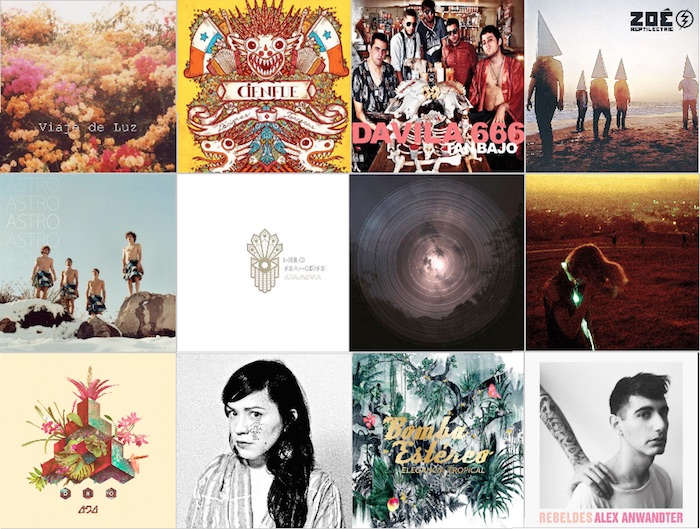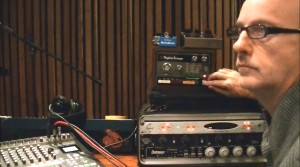Vanishing Borders: Latin American Music Production in a Globalized World
This story first appeared in Trust Me, I’m a Scientist on April 15, 2013.
 If you page through the calendars of South American music festivals, the lineups may seem familiar. Whether in Santiago, Monterrey, Bogotá or San José, you’ll find bands like The Killers, Pearl Jam, DIIV, The Black Keys, Twin Shadow and Ariel Pink’s Haunted Graffiti. You might recognize some of the locals as well: artists like Zoé and Bomba Estéreo. The imports go in both directions, and a select handful of Latin American bands, like Mexico’s Cafe Tacvba, are making the rounds of festivals in the US this season.
If you page through the calendars of South American music festivals, the lineups may seem familiar. Whether in Santiago, Monterrey, Bogotá or San José, you’ll find bands like The Killers, Pearl Jam, DIIV, The Black Keys, Twin Shadow and Ariel Pink’s Haunted Graffiti. You might recognize some of the locals as well: artists like Zoé and Bomba Estéreo. The imports go in both directions, and a select handful of Latin American bands, like Mexico’s Cafe Tacvba, are making the rounds of festivals in the US this season.
The music industry here in South and Central America may have developed slowly, but it is now becoming distinctly modern. Tastes that were once overwhelmingly traditional and localized have shifted through globalization and become more cosmopolitan, almost homogeneous to a degree, as the music of all these nations grows increasingly intertwined. Musicians here are still influenced by their local roots of course, but they are also subject to an tidal influx of foreign styles, techniques and work ethics. That may be a common aspect of all modern music, but the unprecedented spread of new recording technology and web communication have had an especially dramatic impact here.
This applies not only to the Latin American pop music that makes its way to North America under the labels of World, Norteño and Salsa, or to the Shakiras and the Juaneses that break into the US and European markets through a commercial ‘top-down’ approach. There is also a new and dynamic wave of esoteric and independent rock and pop music here today. As NPR’s Jasmine Garsd writes, this new Latin American “alternative” is “a little bit of everything from everywhere, mixed into a completely new Latino soundscape.” These are artists who might never land in the Billboard’s “Hot 100” but attract devoted followings around the world nonetheless. They are artists that belong to a new pan-American web of sound.
The musicians who operate in this realm have connected with new audiences largely thanks to internet media, which has allowed them to resonate in untapped regions, to tour widely, and to begin to find a new global market for their work. In 2012 alone, NPR’s favorite 50 albums list included 5 from Spanish-language artists including Astro, Bomba Estéreo and Café Tacvba. It is as trend that is likely to continue.
For most of these alternative Latin American musicians, releasing an album has been a DIY endeavor in the true sense of the word. But many of them are now beginning to take an even more ambitious approach by reaching out to foreign producers, often from the US or the UK, to help refine their work for this new worldwide market.
Zoé, an acclaimed alternative rock band from Mexico City, have done it both ways: Their earliest releases were self-financed and self-published. After some success, they reached out to producer Phil Vinall, known for his work with influential British artists like Radiohead, XTC, Pulp, Placebo, and Elastica. He has likened hearing Zoé’s music to an “exciting discovery”, in which he was surprised to find that a band from a distinct culture halfway across the world had been incorporating modern British pop influences into their sonic spectrum. Their collaboration produced 2008’s Reptilectric, an album that still remains a major reference point for others in the region.

Phil Vinall at Estudios Audiovisión in Bogotá, Colombia with 69 Nombres (Photo courtesy of Diffusion Magazine and Camilo Silva)
Since then, Vinall has recorded albums for other bands from Mexico, Colombia, and my home of Costa Rica. Even here, in a nation of only 4.7 million people, production values were not overlooked. Although tracking took place in a rural setting far from the capital, recording gear was brought in, much like on sessions for Radiohead’s OK Computer. Vinall is not alone in this. American producers like Jack Endino and Joel Hamilton have often traveled to work in South and Central America in recent years. As these economies continue to grow and to globalize, it’s an approach that only becomes increasingly popular.
Things weren’t always this way. Not long ago, an ambitious band from South and Central America would instead travel abroad to try and make their landmark albums. But that trend seems to have reversed. Take for example Chile’s music productions, which have risen dramatically. Chilean producer/engineer Chalo Gonzalez has worked on more than 60 albums in his 20+ year career, and in his view, the practice of recording abroad could often be a double-edged-sword for the artists involved:
“[In the 90’s] a fashion began [of] recording with foreign producers; most bands wanted to go to Los Angeles, New York, Buenos Aires. Suddenly, the pockets of the record labels started to weaken due to this ‘inflated dream’ kind of thing. There were bands like Solar, who finished their first album in London, and at the end, this mattered more than the band. Javiera y los Imposibles made their first hit and immediately went to London. Their next album was a return to the basics. That’s why I ended up building a studio. Because I realized that we had to create an industry – even if it’s minimal – here.”
Chalo has worked hard to pass this outlook along, and it’s brought him considerable success. His Estudios Triana has hosted recording sessions from across genres – folk, indie rock, pop and electro – and local demand has been great enough to support three full production rooms, all filled with professional equipment. Ironically, the musicians who work with him here have often attracted far more international praise than artists from a generation before, who would jet over to Europe or North America at their very first chance.
In Argentina – a fertile breeding ground for modern rock bands – this practice is even more established. The last generation of regional stars, artists like Gustavo Cerati, Charly García, and Academy Award-winner Gustavo Santaolalla, had already been recording at a couple of Argentinian studios, particularly Estudio ION and Estudio Panda. Today, ambitious new musicians, often seeking greater international exposure, are taking that same route even as they focus on selling their music abroad. Recently Luz, La Perla Regular, Los Gongs, Valentin y los Volcanes, have all recorded within these local studios, sometimes mixing elsewhere or mastering overseas, just like so many other artists from around the developed world.
From within, the musical panorama of Latin America appears exactly as it is: energetic and prolific. But that view is not always shared by outsiders, who sometimes assume it is still at such a nascent stage. If the recording culture here has already come so far, what challenges still need to be overcome?
Demand for this kind of music certainly does not seem to be the problem. Instead, the issues that musicians face here are often the same as elsewhere: funding and effective commercial distribution. Contemporary South and Central American artists often release of their material entirely by themselves, and even though they are invited to festivals and concerts with increasing frequency, a wider commercial dispersal of their recorded work is critical to obtaining more sustainable results.
It’s sometimes difficult to track sales and fan-bases when artists self-release, but if it’s any indication, social media pages for these bands are often incredibly popular, with tens or even hundreds of thousands of Facebook “Likes”. But what does this mean for a band’s success or sustainability? Many of these social media fans can be young (some of them still in their early teens) or widely spread across Spanish-speaking nations, often unable to buy physical albums or to attend concerts.
One Costa Rican band, Las Robertas, has earned over 8,000 likes on its Facebook profile (perhaps one of the few practical measures of success available to an independent band here) and that has helped secure them enough international attention to play in both Spain’s Primavera Sound and SWSX in the US. Does simply gaining enough recognition to play overseas make a band like this “successful”? To a certain extent, yes. But we also need to remember that one of the biggest goals of globalization is to create a two-way street. Everything can be opened: bigger markets into smaller ones and vice-versa.
Here in Latin America, there is an untapped appetite for modern music – ambitious albums that speak as part of a global conversation. Today, thanks to the proliferation of recording technology, that music will no longer be import-only. There are incredible new languages of sound being developed here every day, just waiting to be embraced, both close to home and around the world.
In an essay about the spread of new recording technologies in South America, Mexican educator Maria del Carmen de la Peza contends that “no other technology has permeated society at such a rate.” Referencing a new explosion of interest in Latin American music in countries as far flung as Japan, she argues that instead of “thinking in terms of how Western culture dominates, modifies or transforms local cultures,” we might notice how language-centered culture is being transformed into a new culture of sound, in which the rigid barriers once created by words no longer hold the same power.
That is the transformation that is happening now. And only new generations will be able to embrace it to its fullest.
Please note: When you buy products through links on this page, we may earn an affiliate commission.






